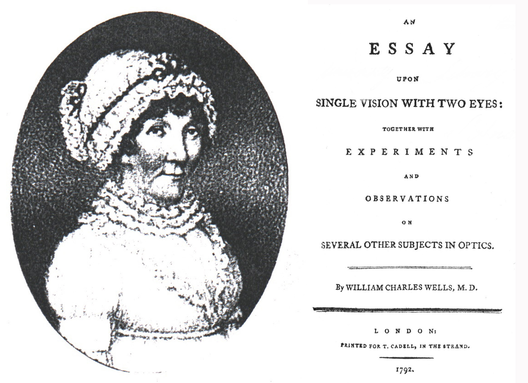William Charles Wells1757–1817
Wells is another pioneer of neuroscience for whom no portrait has been found. Thus he is presented by proxy, with a portrait of his sister (Louisa Susannah Wells, 1755-1831) and the title page of his book on binocular single vision. Wells was born in Charlestown, South Carolina, of Scottish parents, but from the age of ten his education was almost entirely in Scotland, initially at Dumfries and then at Edinburgh University. He spent the years between 1771 and 1775 apprenticed to Alexander Garden (1730-91), a Scot who practiced medicine in Charlestown. On the outbreak of the Revolution the Wells family returned to Britain, and William studied medicine at Edinburgh University, graduating in 1780. He returned to America, in order to recover his father’s printing property, but became embroiled in the conflict. After four years in America he returned to Britain to practice medicine in London, although his practice was not successful and his income was derived from his appointment as physician first at Finsbury Dispensary (1790) and then at St. Thomas’s Hospital (1800). He is best known for his Essay on dew on the basis of which he was awarded the Rumford medal in 1816. Wells published An essay upon single vision with two eyes in 1792, and he retained an interest in visual phenomena throughout his life. It was concerned with more than binocular single vision, and among the ‘other topics in vision’ he addressed were eye movements, accommodation, acuity, and visual vertigo. Wells was a revolutionary but his revolution was not concerned with the body politic rather with the body anatomic. He investigated the consequences of body rotation and the visual vertigo that follows it when the body is still. In so doing, he showed how the eyes moved in phases of slow drifts and ballistic returns (nystagmus). These were the first experimental studies of eye movements, and his technique of comparing the motion of an afterimage (which was fixed on the retina) with a real image (which was not) constituted a novel approach to an age old issue. His interpretation of vertigo was at variance with that given by Erasmus Darwin in his Zoonomia, which led Wells to conduct further experiments on torsional nystagmus. His ideas on evolution were expressed late in his life, in a paper delivered to the Royal Society (in 1813) but not published in its Transactions. Commenting on the case of a white woman, part of whose skin was black he proposed a process of change that was akin to natural selection. His ideas were acknowledged by Charles Darwin in the fourth edition of On the origin of species. Wells made several medical advances. He speculated on the basis for the colour of blood; the received opinion was that it was due to the presence of iron in blood. Wells excluded that hypothesis on the basis of a series of experiments, and concluded that: “Upon the whole it appears to me, that blood derives its colour from the peculiar organization of the animal matter of one of its parts”. He forged the link between rheumatism and heart disease. The results of most of his medical research were presented to a small but select Society for the Improvement of Medical and Chirurgical Knowledge and then published in the society’s Transactions. The society was founded by John Hunter (1728-1793) and Fordyce in 1783. It was a dining club with a very restricted membership, originally only nine. Meetings were held once a month at Slaughter’s coffee-house in St. Martin’s Lane, London and Wells was effectively the secretary; he took great pains over the papers presented and published. According to his stated wish the society was dissolved after his death, and the Transactions only ran to three volumes, published in 1793, 1800 and 1812.
